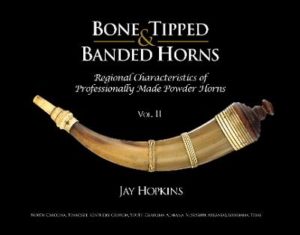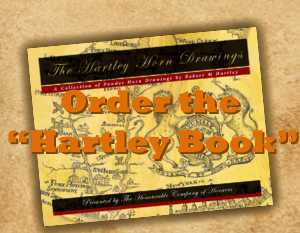The Question of Imported Horns
September 26, 2011 by Bill Carter
Filed under Articles from the Archives
The following article by Byron Smith was first published in the September 1999 issue of The Horn Book. It gives some excellent insights into the horn trade which I think you will enjoy.
– Bill Carter, Editor and Journeyman Horner
The Question of Imported Horns
By Byron C. Smith
In the 26 July 1759 Pennsylvania Gazette, an advertisement appeared which announced that a diverse quantity of goods had been imported “in the last Vessels from Bristol and London.” The announcement went on to say that they would be “sold wholesale or retail, at BLANCH WHITE’S Upholstery Warehouse, the Crown and Cushion, in Front Street, near the London Coffee House, Philadelphia.” Among the listed items are things that you would expect to see in a shop called “the Crown and Cushion,” such as “Upholsterers buckrams, furniture checks, erminettas,” as well as sundry other goods related to the textile trade. It is among the listings of hardware goods that we begin to see the things you would not expect to find in an “Upholstery Warehouse.” Among the “pullies, cranks and wire” we find “brass mounted swords,” and “fence pan gun locks.” Just before a listing for “steel mounted swords gilt with gold,” the ad mentions “powder horns and flasks.”
It is this reference to horns and flasks that we will address herein. My purpose in writing this article is to raise questions and the appearance and prevalence of imported powder horns. I also wish to touch on the evidence for specialization in the field of horn work and the implications this has on our understanding of the horn trade. It should be no surprise that horn powder flasks were being imported from Europe where they were being manufactured cheaply and efficiently. Indeed, considering the manufacturing power of Britain during the third quarter of the 18th century, it should not astonish us that powder horns were being imported from Britain in 1759. Obviously there were horns being made professionally in Philadelphia at the time. Nevertheless, during the years I have been studying the subject I have not heard much discussion of the role of these imported horns would have played in the American market. In short, we should be asking what did these horns look like and how many of them are out there, mislabeled as professionally made American horns?
Since 1759 was a peak year during the French and Indian War, one would expect that many goods with military value were being imported into America. In fact, the same advertisement closes with an addendum which includes listings for “Drums and colours, halberts, spontoons, filed bedsteads, mattrasses, valances, and all kind of military accouterments and filed equipage.” The listing ends with the assertion that these items were all “ready made” and available “at the lowest prices, as in London.”
This final boast is critical to our understanding of the Colonial import market and why is was profitable for Blanch White’s Upholstery Warehouse to be selling powder horns made on the other side of the Atlantic instead of ones being made right in Philadelphia. By 1759 the Industrial Revolution had already begun in Britain. Cities like London and Bristol were filling up and would soon become over-populated with former agricultural workers who continued to leave the rural regions of England to seek urban employment as semi-skilled laborers. This influx of cheap labor combined with developments in mass production technology meant that the production of goods could be divided into sub-manufacturing trades.
For instance, according the 21 February 1747 issue of The Gentleman’s Magazine [page 101], the trade of the gunsmith in England had, by that time, already been divided into 21 different sub-trades. This high degree of specialization insured that guns were being mass produced very cheaply and efficiently in cities like London and Birmingham. These guns (the vast majority were smooth bored) were being exported to America and sold by import merchants in places like Philadelphia, Boston, or Williamsburg. It is quite possible that the same manner of specialization and cheap manufacturing methods were taking root in the horn working trades as well.
There are a few clues in the literature from that time about the advent of specialization in horn working. According to R. Campbell’s The London Tradesman (published in London, 1747), the Horner is “of Kindred to the Turner, as he turns a great many of the Articles he deals in, which are both numerous and useful.” Campbell has nothing more to say about the items the horners made, but he does add that the horner’s trade is not considered among “the most polite Trades.” He goes on to say that it is “a very useful one, for the stench of the Horn, which they sometimes manufacture with the Heat of the Fire, keeps them from the Hyp, Vapours and Lowness of Spirits, the common malady of England.” In short, it is clear that Campbell did not know much about the horner’s trade. Indeed, the health benefits were all the encouragement that Campbell could give the prospective apprentice other than to say that a journeyman horner could earn “from Twelve to Eighteen Shillings a Week.”
As for his assessment of the turner’s trade, Campbell hints that specialization was well under way by 1747. He wrote that the turners’ trade “is a very ingenious Business and brought to great Perfection in this Kingdom.” He continues that they “differ among themselves according to the materials they use; some turn Wood, others Ivory, Tortoise-Shell, &c, and others Metal, Iron, Brass, Gold or Silver.” He did not mention horn as one of the specialty materials, presumably because he saw the horner as a kind of specialized turner. His essay on turners closes with this statement: “There is an infinite Variety in their Work, and they must be learning all their Life.”
Campbell is less kind to the horn-working comb makers. He wrote that comb maker’s work “neither requires much Labour, Education or Ingenuity,” adding that “It is none of the most profitable Branches to the Master; they earn an honest Subsistence, but though their business is but in few Hands, I never heard of any of them who died remarkably rich.” He notes that a journeyman comb-maker could earn “from Twelve to Fifteen Shillings a Week.” If you recall, a journeyman horner might only expect two more shillings per week. In other words, despite the small number of active comb makers, they could not make a decent living just by making combs. It seems that most types of horners were in the same situation.
The question must be asked then, why were comb makers not diversifying? Perhaps the answer is in their trade name. Is it not possible that comb makers are specialized horner workers who, in response to a growing market, focused on one aspect of the trade? Could it be that generalist horn workers had originally claimed the comb making trade but lost it to those horners who specialized in response to a demand for mass produced cheap horn combs? If this was the case, the evidence seems to indicate that here in America, that sort of specialization was not rewarded in the limited Colonial market.
Returning to the Pennsylvania Gazette, there was at least one American comb maker who was, like many American tradesman during the Colonial era, not limiting himself to one specialty. In the 4 October 1759 Issue, Christopher Anger, “Combmaker,” advertises that he had moved his shop from “Second Street, [at] the Corner of Chestnut Street” to a new location in “Strawberry Alley, within four Doors of Samuel Howell’s Store.” Anger added that customers who visited his new location would “be supplied with all Sorts of Combs, Wholesale and Retail; Also with Powder Horns, and Punch Spoons, &c.” In other words, Anger was a horner who made powder horns, punch spoon and other horns products, but thought of himself as a “Combmaker.” There is even evidence that he considered himself as akin to a turner.
Another key advertisement appears in the 16 February 1764 issue of the Pennsylvania Gazette. It read:
“THOMAS DUNN, Turner, from London, PERFORMS all sorts of Turner’s Work in the Best Manner, in Horn, Ivory, Silver or Brass; he likewise makes Horn Flasks, Butchers Steel Handles, Needle Cases, Nutmeg graters of Horn or Ivory, Horn Pipe Stems, turns Billiard balls, Dice boxes, and Table men, Cane heads, all Sorts of Inkhorns, oval Snuff boxes, Punch ladles, Buttons, curious Flower pots for Ladies, Ivory needles for drawing Ribbons into ladies Caps, horn Tumbler, Shaving brushes, Whip handles of Horn or Wood, &c. Likewise Tortoiseshell Rings made and sold, wholesale or retail, by said Thomas Dunn, at Christopher Anger’s at the Sign of the Comb maker in Strawberry alley, Philadelphia.”
Clearly Anger and Dunn were sharing a workshop and storefront. They are clearly both horners, but Dunn as a turner was specializing at all. Unlike his fellow turners in London whom Campbell described, Dunn was not defining himself as a turner limited to working only with horn. Such specialization was the sure road to financial ruin in America, where skilled craftsmen were fewer in number and where the Industrial Revolution had yet to make inroads.
Now we can return to the imported horns being sold at Blanch White’s Upholstery warehouse, in that same year when Christopher Anger offered his American made powder horns in his shop. Without being able to see these horns and know their prices, so that we can compare them to Anger’s horns, it is impossible to draw any certain conclusions. Even so, if we can believe that the imported horns were being sold cheaper than Anger could sell his, it seems possible that Anger and his fellow American horners were offering items not available on the import market. Could it be that Anger and his fellow tradesmen were offering custom made horns, or even a new American style powder horn that was not made elsewhere? If so, what did this new American style powder horn look like and how was it different from the cheap mass produced horns coming from horn shops in London? Unfortunately I do not have those answers. I look forward to hearing from those of you who think that you might have the answers to these questions.




